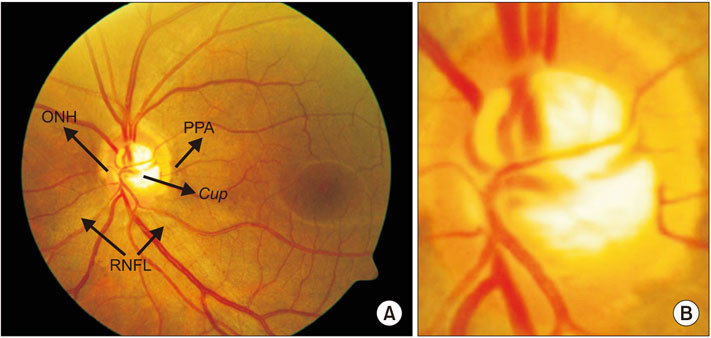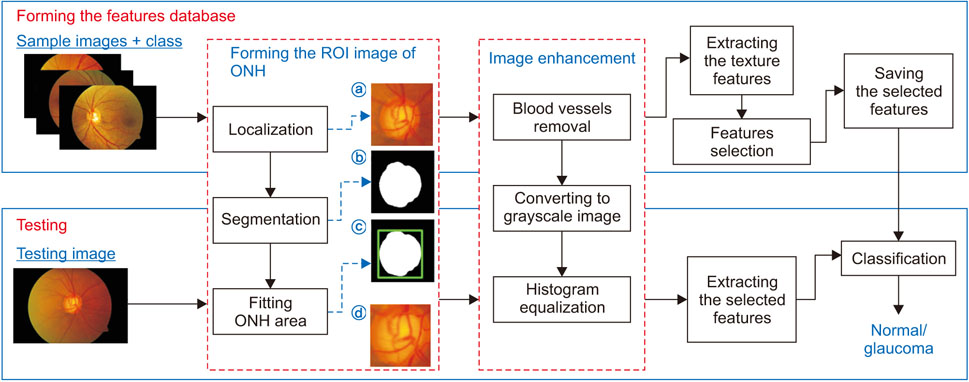Healthc Inform Res.
2018 Jan;24(1):53-60. 10.4258/hir.2018.24.1.53.
Automatic Glaucoma Detection Method Applying a Statistical Approach to Fundus Images
- Affiliations
-
- 1Department of Computer Science, Faculty of Computer Science and Information Technology, Mulawarman University, Samarinda, Indonesia. anindita.septiarini@gmail.com
- KMID: 2403296
- DOI: http://doi.org/10.4258/hir.2018.24.1.53
Abstract
OBJECTIVES
Glaucoma is an incurable eye disease and the second leading cause of blindness in the world. Until 2020, the number of patients of this disease is estimated to increase. This paper proposes a glaucoma detection method using statistical features and the k-nearest neighbor algorithm as the classifier.
METHODS
We propose three statistical features, namely, the mean, smoothness and 3rd moment, which are extracted from images of the optic nerve head. These three features are obtained through feature extraction followed by feature selection using the correlation feature selection method. To classify those features, we apply the k-nearest neighbor algorithm as a classifier to perform glaucoma detection on fundus images.
RESULTS
To evaluate the performance of the proposed method, 84 fundus images were used as experimental data consisting of 41 glaucoma image and 43 normal images. The performance of our proposed method was measured in terms of accuracy, and the overall result achieved in this work was 95.24%, respectively.
CONCLUSIONS
This research showed that the proposed method using three statistics features achieves good performance for glaucoma detection.
Keyword
MeSH Terms
Figure
Cited by 1 articles
-
Automated Detection of Retinal Nerve Fiber Layer by Texture-Based Analysis for Glaucoma Evaluation
Anindita Septiarini, Agus Harjoko, Reza Pulungan, Retno Ekantini
Healthc Inform Res. 2018;24(4):335-345. doi: 10.4258/hir.2018.24.4.335.
Reference
-
1. Quigley HA. Number of people with glaucoma worldwide. Br J Ophthalmol. 1996; 80(5):389–393.
Article2. Quigley HA, Broman AT. The number of people with glaucoma worldwide in 2010 and 2020. Br J Ophthalmol. 2006; 90(3):262–267.
Article3. Gamero GE, Robert DF. The optic nerve in glaucoma. In : Choplin NT, Lundy D, editors. Atlas of glaucoma. 2nd ed. Boca Raton (FL): CRC Press;2007.4. Septiarini A, Harjoko A. Automatic glaucoma detection based on the type of features used : a review. J Theor Appl Inf Technol. 2015; 72(3):366–375.5. Salam AA, Khalil T, Akram MU, Jameel A, Basit I. Automated detection of glaucoma using structural and non structural features. Springerplus. 2016; 5(1):1519.
Article6. Issac A, Partha Sarathi M, Dutta MK. An adaptive threshold based image processing technique for improved glaucoma detection and classification. Comput Methods Programs Biomed. 2015; 122(2):229–244.
Article7. Marin D, Gegundez-Arias ME, Suero A, Bravo JM. Obtaining optic disc center and pixel region by automatic thresholding methods on morphologically processed fundus images. Comput Methods Programs Biomed. 2015; 118(2):173–185.
Article8. Septiarini A, Harjoko A, Pulungan R, Ekantini R. Optic disc and cup segmentation by automatic thresholding with morphological operation for glaucoma evaluation. Signal Image Video Process. 2017; 11(5):945–952.
Article9. Muramatsu C, Nakagawa T, Sawada A, Hatanaka Y, Hara T, Yamamoto T, et al. Automated segmentation of optic disc region on retinal fundus photographs: comparison of contour modeling and pixel classification methods. Comput Methods Programs Biomed. 2011; 101(1):23–32.
Article10. Mary MC, Rajsingh EB, Jacob JK, Anandhi D, Amato U, Selvan SE. An empirical study on optic disc segmentation using an active contour model. Biomed Signal Process Control. 2015; 18:19–29.
Article11. Cheng J, Liu J, Xu Y, Yin F, Wong DW, Tan NM, et al. Superpixel classification based optic disc and optic cup segmentation for glaucoma screening. IEEE Trans Med Imaging. 2013; 32(6):1019–1032.
Article12. Khalid NE, Noor NM, Ariff N. Fuzzy c-means (FCM) for optic cup and disc segmentation with morphological operation. Procedia Comput Sci. 2014; 42:255–262.
Article13. Welfer D, Scharcanski J, Marinho DR. A morphologic two-stage approach for automated optic disk detection in color eye fundus images. Pattern Recognit Lett. 2013; 34(5):476–485.
Article14. Mookiah MR, Acharya UR, Lim CM, Petznick A, Suri JS. Data mining technique for automated diagnosis of glaucoma using higher order spectra and wavelet energy features. Knowl Based Syst. 2012; 33:73–82.
Article15. Annu N, Justin J. Classification of glaucoma images using wavelet based energy features and PCA. Int J Sci Eng Res. 2013; 4(5):1369–1374.16. Dey A, Bandyopadhyay SK. Automated glaucoma detection using support vector machine classification method. Br J Med Med Res. 2016; 11(12):1–12.
Article17. Singh A, Dutta MK, ParthaSarathi M, Uher V, Burget R. Image processing based automatic diagnosis of glaucoma using wavelet features of segmented optic disc from fundus image. Comput Methods Programs Biomed. 2016; 124:108–120.
Article18. Noronha KP, Acharya UR, Nayak KP, Martis RJ, Bhandary SV. Automated classification of glaucoma stages using higher order cumulant features. Biomed Signal Process Control. 2014; 10(1):174–183.
Article19. Karthikeyan S, Rengarajan N. Performance analysis of gray level cooccurrence matrix texture features for glaucoma diagnosis. Am J Appl Sci. 2014; 11(2):248–257.
Article20. Ali MA, Hurtut T, Faucon T, Cheriet F. Glaucoma detection based on local binary patterns in fundus photographs. In : Proceedings of SPIE Medical Imaging 2014: Image Processing; 2014 Feb 16-18; San Diego, CA.21. Aruchamy S, Bhattacharjee P, Sanyal G. Automated glaucoma screening in retinal fundus images. Int J Multimed Ubiquitous Eng. 2015; 10(9):129–136.
Article22. Murthi A, Madheswaran M. Medical decision support system to identify glaucoma using cup to disc ratio. J Theor Appl Inf Technol. 2014; 68(2):406–413.23. Septiarini A, Hamdani , Khairina DM. The contour extraction of cup in fundus images for glaucoma detection. Int J Electr Comput Eng. 2016; 6(6):2797–2804.
Article24. Sheshadri HS, Kandaswamy A. Breast tissue classification using statistical feature extraction of mammograms. Med Imaging Inf Sci. 2006; 23(3):105–107.25. Kim TY, Son J, Kim KG. The recent progress in quantitative medical image analysis for computer aided diagnosis systems. Healthc Inform Res. 2011; 17(3):143–149.
Article26. Wiharto W, Kusnanto H, Herianto H. Interpretation of clinical data based on C4.5 algorithm for the diagnosis of coronary heart disease. Healthc Inform Res. 2016; 22(3):186–195.
Article27. Yousefi S, Goldbaum MH, Balasubramanian M, Jung TP, Weinreb RN, Medeiros FA, et al. Glaucoma progression detection using structural retinal nerve fiber layer measurements and functional visual field points. IEEE Trans Biomed Eng. 2014; 61(4):1143–1154.
Article28. Ashraf M, Chetty G, Tran D, Sharma D. Hybrid approach for diagnosing thyroid, hepatitis, and breast cancer based on correlation based feature selection and Naive Bayes. In : Huang T, Zeng Z, Li C, Leung CS, editors. Neural Information Processing. Heidelberg: Springer;2012. p. 272–280.29. Vanaja S, Kumar KR. Analysis of feature selection algorithms on classification : a survey. Int J Comput Appl. 2014; 96(17):28–35.30. Saeys Y, Inza I, Larranaga P. A review of feature selection techniques in bioinformatics. Bioinformatics. 2007; 23(19):2507–2517.
Article31. Hall MA, Smith LA. Feature selection for machine learning: comparing a correlation-based filter approach to the wrapper. In : Proceedings of the 12th International FLAIRS Conference; 1999 May 1-5; Orlando, FL. p. 235–239.32. Kotsiantis SB. Supervised machine learning: a review of classification techniques. Informatica. 2007; 31:249–268.
- Full Text Links
- Actions
-
Cited
- CITED
-
- Close
- Share
- Similar articles
-
- Automatic Method for Optic Disc Segmentation Using Deep Learning on Retinal Fundus Images
- The Significance of Fundus Photography Without Mydriasis During Health Mass Screening
- Automated Detection of Retinal Nerve Fiber Layer by Texture-Based Analysis for Glaucoma Evaluation
- The Comparison of SLO Retromode Images with Conventional Fundus Photography for the Detection of Drusen
- Automated Techniques for the Sectioned Images of Visible Korean




